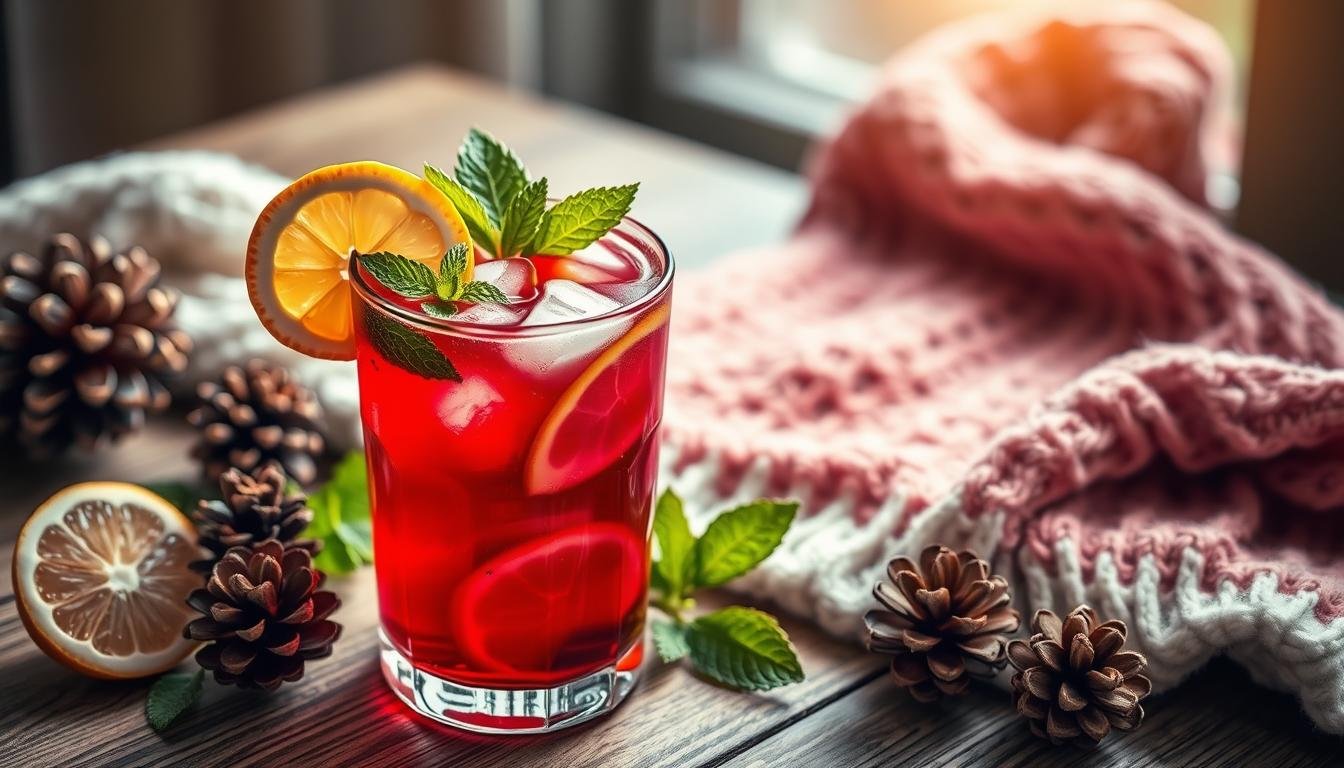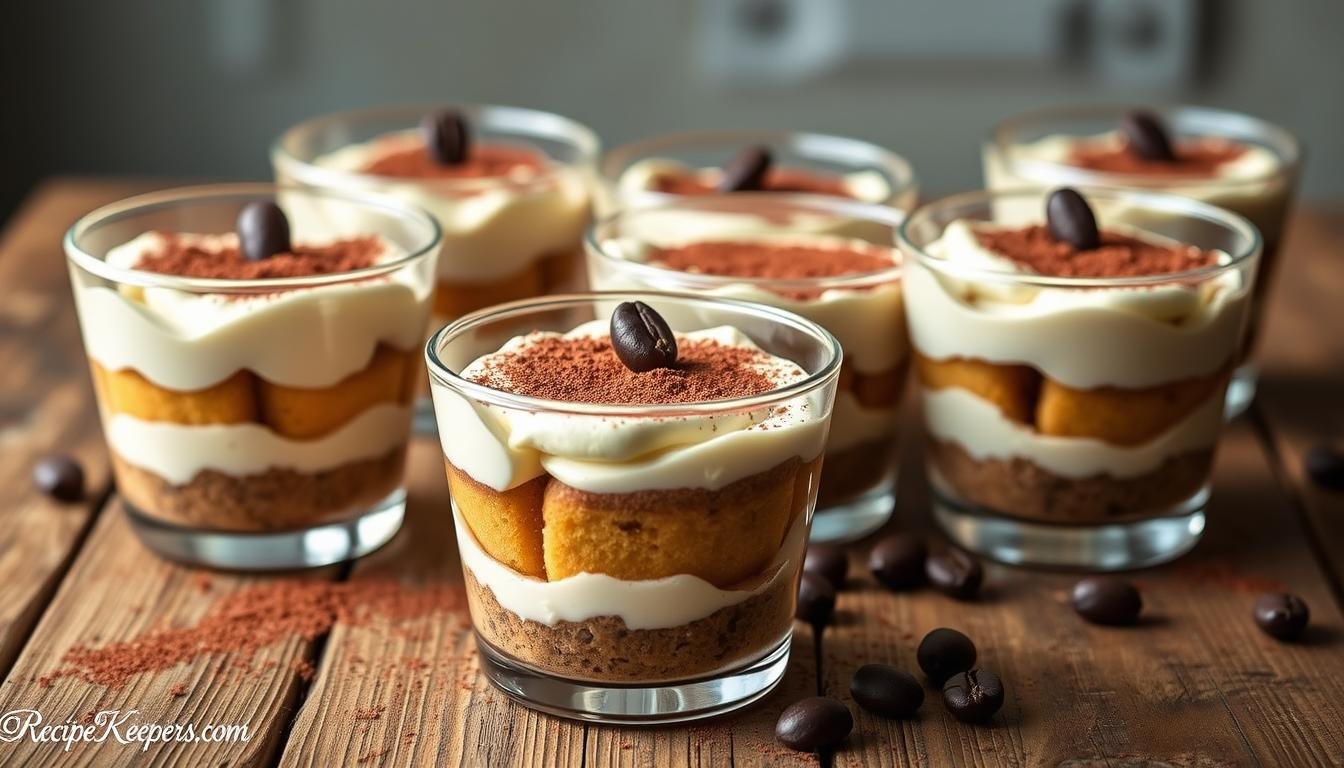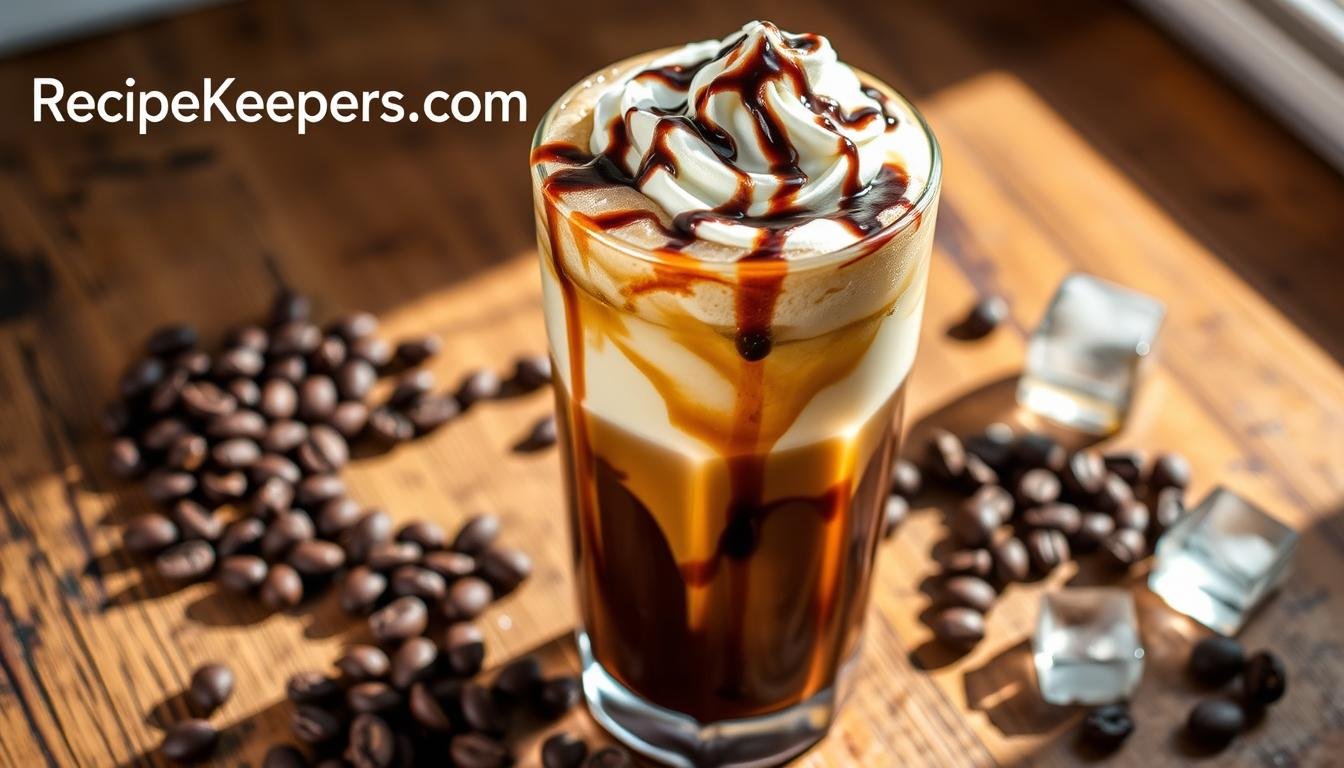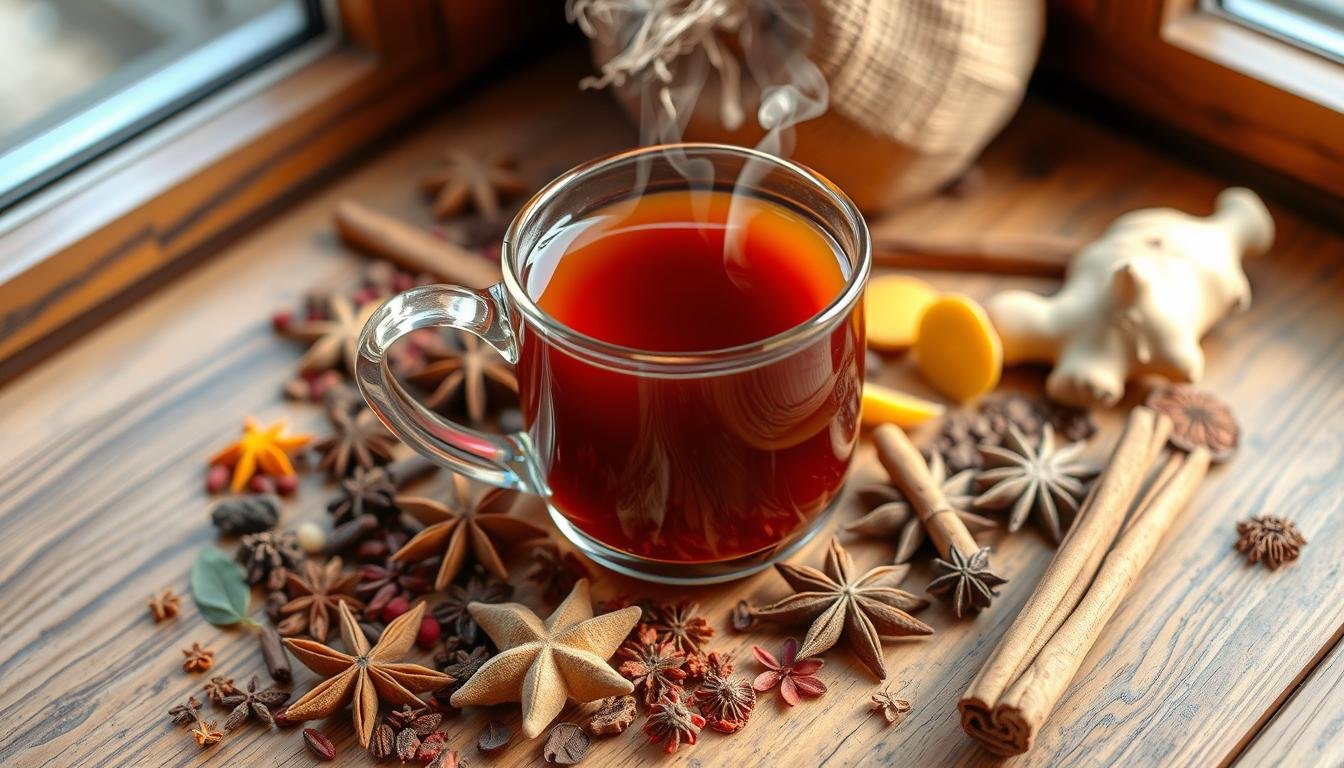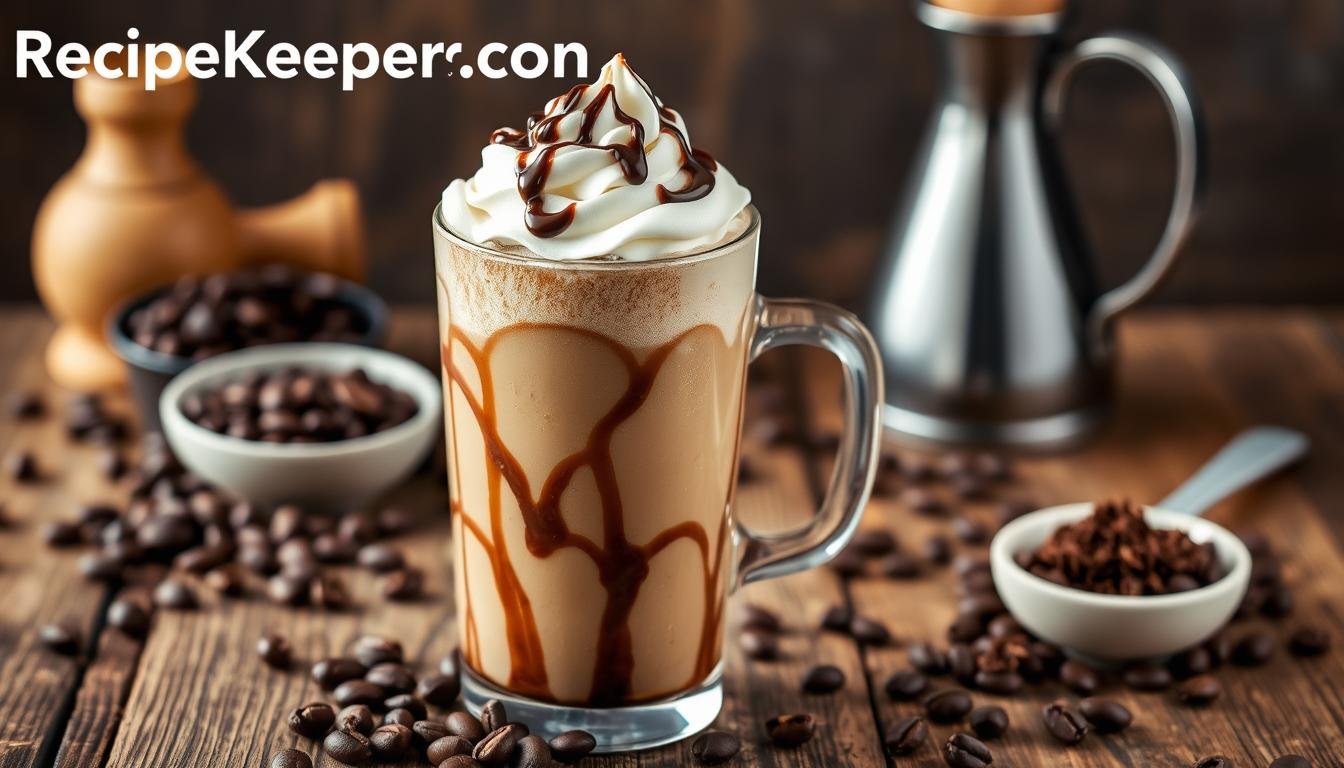Winter doesn’t mean saying goodbye to delicious hibiscus iced tea! We’re going to turn this vibrant ruby-red drink into a warm winter treat. It will excite your taste buds and boost your health.
Hibiscus tea comes from Central and West Africa. It has traveled the world and is loved everywhere. This caffeine-free drink is full of flavor and health benefits, perfect for cold days.
Picture yourself sipping a warm cup of hibiscus tea. It tastes amazing and is good for you. With vitamins C and beta-carotene, it’s more than a drink. It’s a way to care for yourself.
Key Takeaways
- Hibiscus tea is a versatile, caffeine-free drink for all seasons
- Rich in antioxidants and potential health benefits
- Easy to prepare with minimal ingredients
- Connects culinary traditions from around the world
- Can be enjoyed hot or cold, perfect for winter
What Makes Hibiscus Tea Special
Explore the world of warming hibiscus tea, a unique seasonal herbal tea loved by many. It’s not just a tasty drink; it’s a journey through tradition and wellness.
Understanding Hibiscus Sabdariffa
Hibiscus sabdariffa is a tropical wonder that turns into a special tea. Its bright red calyces are picked to make a tea that looks and tastes amazing. This plant comes from Africa and Asia and has been loved for ages.
- Originates from tropical and subtropical regions
- Primarily grown in Africa, Jamaica, and East Asia
- Harvested from the flower’s vibrant red calyces
Cultural Significance Worldwide
Hibiscus tea is loved in many places, from Mexico to Egypt. Each culture adds its own special touch to this drink. It’s more than a drink; it’s a global culinary adventure.
The Unique Flavor Profile
This tea has a unique taste that stands out. It’s like a mix of cranberries and flowers. The flavor is bold, bright, and refreshing, making it a memorable drink.
| Flavor Characteristics | Taste Notes |
|---|---|
| Primary Taste | Tart and fruity |
| Secondary Notes | Subtle floral undertones |
| Color | Rich magenta |
Looking for a drink for winter or summer? Hibiscus tea offers a unique taste journey that connects you to global traditions.
Health Benefits of Hot Hibiscus Tea in Winter
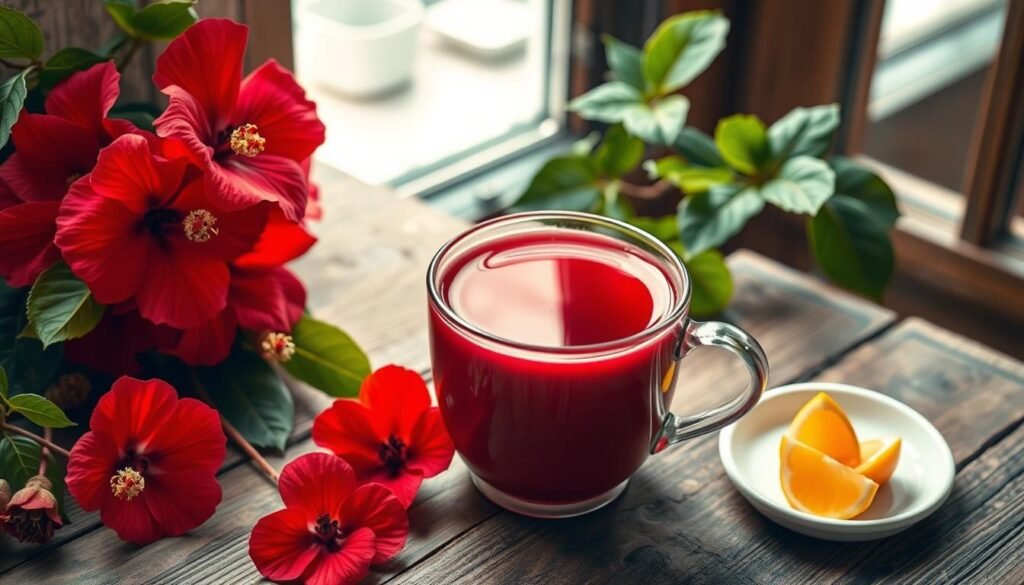
Winter is the perfect time to enjoy a cozy drink that warms you up and boosts your health. Spiced hibiscus tea is a great choice. It’s not just tasty; it’s also full of nutrients.
Our family loves this tea for its flavor and health benefits. It’s packed with minerals like calcium, iron, and potassium. Plus, it’s low in calories and doesn’t have caffeine, making it a great choice for winter.
- Blood Pressure Management: Studies show hibiscus tea can lower blood pressure by up to 7.2 points
- Weight Loss Support: It has acids and flavonoids that might help with metabolism
- Rich in Antioxidants: It fights off free radicals and chronic diseases
- Immune System Booster: One cup gives you about 18% of your daily vitamin C
Research has found many health benefits of drinking hibiscus tea. A 2009 study found it could lower cholesterol levels, especially for people with type II diabetes. It also has anti-inflammatory properties that can help with metabolic health.
When making your spiced hibiscus tea, try using honey instead of sugar. Honey adds sweetness and extra nutrients without many calories.
Even though hibiscus tea is healthy, it’s smart to talk to a doctor first. This is especially true if you have health issues or take medications.
Essential Ingredients for Perfect Hibiscus Tea
To make the best hibiscus iced tea or hot tea for winter, you need the right ingredients. Let’s explore the key elements that turn a simple drink into a winter delight.
Quality ingredients are crucial for making great hibiscus tea. We start by choosing the best base for our winter drinks.
Selecting Quality Dried Hibiscus Flowers
The core of any excellent hibiscus tea is its main ingredient. Look for dried hibiscus flowers that have:
- Bright, vibrant red color
- Strong, fragrant aroma
- Organic, pesticide-free sourcing
- Whole, intact flower petals
Pro tip: Find top-notch dried hibiscus flowers at specialty tea shops or local markets.
Optional Flavor Enhancers
Add these ingredients to enhance your hibiscus iced tea:
| Ingredient | Flavor Profile | Recommended Quantity |
|---|---|---|
| Cinnamon Stick | Warm, spicy | 1 stick per 4 cups |
| Fresh Ginger | Zesty, sharp | 2-3 thin slices |
| Cloves | Intense, aromatic | 2-3 whole cloves |
Water Quality Considerations
Water might seem simple, but it greatly affects your hibiscus tea’s taste. Use filtered water for a clean, pure flavor. This lets the hibiscus shine without interference.
Creating the perfect hibiscus tea is an art. Try these ingredients to make your own unique winter drink that warms your body and soul.
Hibiscus Iced Tea (served hot for winter)
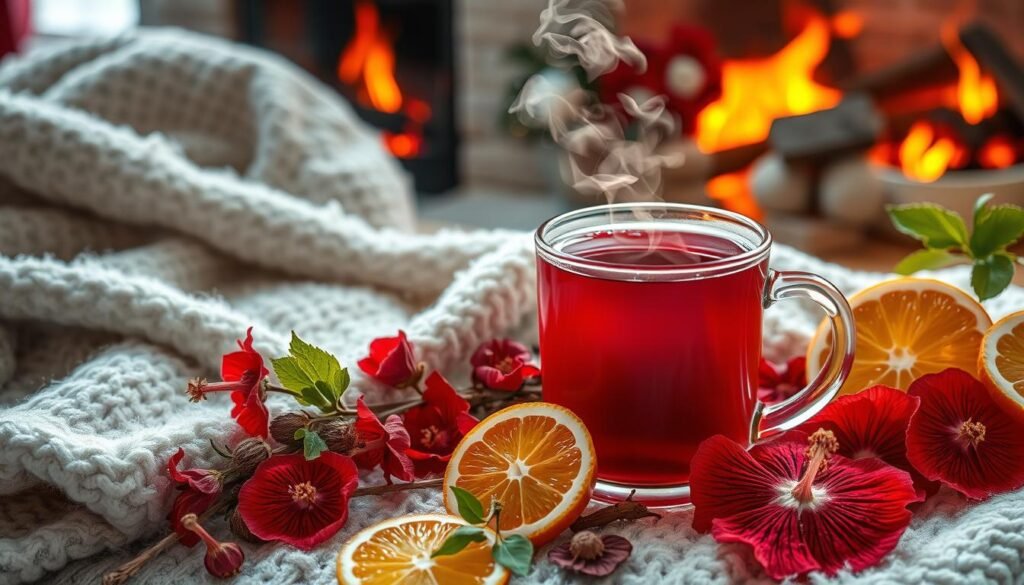
Turn your favorite herbal tea into a cozy winter friend! Hibiscus tea adds a fun twist to hot drinks, warming you up on cold days. Rishi Tea experts say it’s easy to make hot hibiscus tea from iced tea.
To make the best hot hibiscus tea, focus on a few important steps. Begin with top-notch dried hibiscus petals. Use 1 tablespoon for every cup of water. Steeping it right is key to getting the best flavor and color.
- Use boiling water (4 cups recommended)
- Steep for 10-30 minutes
- Strain carefully to remove flower petals
- Serve immediately while hot
This tea is not only tasty but also good for you. A single cup has just 39 calories. It tastes a bit tart, like cranberry.
| Nutritional Content | Per Cup |
|---|---|
| Calories | 39 kcal |
| Carbohydrates | 10g |
| Sugar | 10g |
| Sodium | 12mg |
For extra warmth, try adding honey or a bit of cinnamon. Hibiscus tea is great for winter parties or cozy nights at home.
Traditional Brewing Methods
Making the perfect spiced hibiscus tea is all about two main brewing methods. These methods bring out the rich flavors of this winter favorite. Whether you want a quick warm-up or a slow-steeped treat, we’ll show you how to make it.
Hot Brewing Method
The hot brewing method is the top choice for a fast, cozy drink. Here’s how to make a tasty spiced hibiscus tea:
- Use fresh boiling water (212°F)
- Select high-quality dried hibiscus flowers
- Steep for 5-10 minutes
- Strain and enjoy immediately
Cold Brewing Technique
Cold brewing gives you a smoother, less acidic tea. It takes time but is worth it:
- Use room temperature water
- Steep hibiscus flowers overnight (8-9 hours)
- Refrigerate after straining
- Consume within 3-4 days
| Brewing Method | Steeping Time | Flavor Intensity | Storage Duration |
|---|---|---|---|
| Hot Brewing | 5-10 minutes | Strong | 1-2 days |
| Cold Brewing | 8-9 hours | Mild | 3-4 days |
Pro tip: To make your spiced hibiscus tea even better, try adding cinnamon sticks or ginger. It will turn your cozy drink into a special treat.
Spice Variations for Winter Warmth
Winter drinks like hot hibiscus tea become magical with the right spices. We’ll explore exciting flavor combinations to make your hibiscus iced tea special.
Cinnamon and Clove Combinations
Cinnamon and cloves add warmth to your hot hibiscus tea. These spices bring depth and complexity. Here’s how to get the best flavor:
- Use 1-2 whole cinnamon sticks per brewing
- Add 3-4 whole cloves for intense flavor
- Let spices steep for 5-7 minutes
Ginger Infusion Techniques
Ginger adds a zesty kick to hibiscus tea, making it a great winter drink. You can use fresh or dried ginger to boost the flavor.
| Ginger Type | Preparation Method | Flavor Intensity |
|---|---|---|
| Fresh Ginger | Grate 1-inch piece directly into tea | Strong, sharp |
| Dried Ginger | Use 1/2 teaspoon ground ginger | Mild, consistent |
| Ginger Root Slice | Steep whole slice for 10 minutes | Moderate, balanced |
Seasonal Spice Blends
Making your own spice blend can make hibiscus iced tea unique. Try mixing cardamom, star anise, and orange peel to find your favorite winter drink.
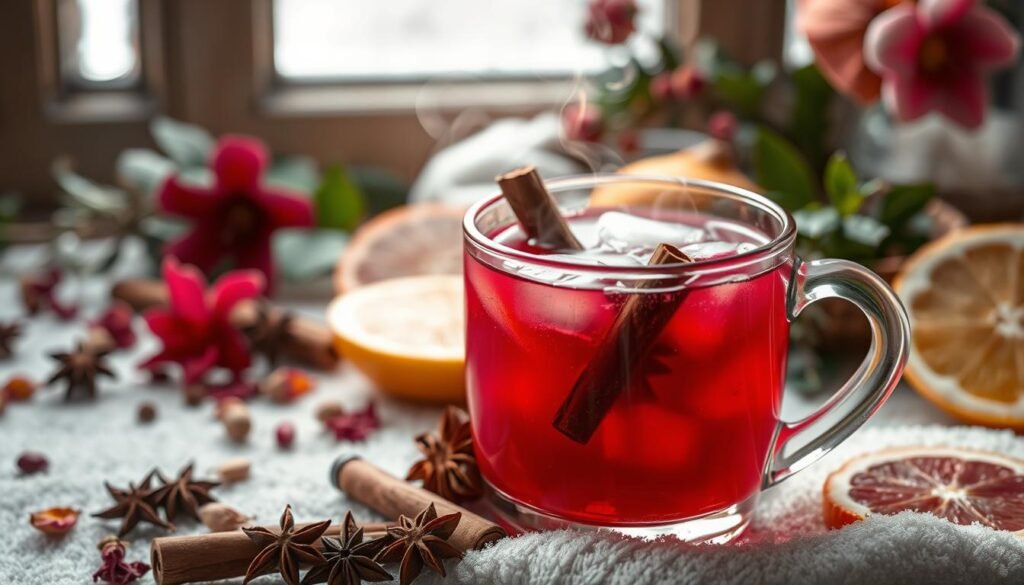
Pro tip: Start with small amounts of spices and adjust to taste. Each pinch brings your hibiscus tea closer to winter perfection!
Sweetening Options for Your Tea
When you make hot beverages like warming hibiscus tea, finding the right sweetness is key. The natural tartness of hibiscus tea needs creative sweetening to bring out its unique taste.
Here are the best ways to sweeten your hibiscus tea:
- Natural Sweeteners
- Raw honey (adds depth and complexity)
- Organic agave syrup
- Pure maple syrup
- Traditional Sweeteners
- Organic cane sugar
- Brown sugar
- Stevia (for low-calorie option)
For unique flavor mixes, try these sweetening methods:
- Apple juice splash for fruity sweetness
- Ginger ale for fizzy excitement
- Fresh fruit purees
| Sweetener | Calories per Teaspoon | Sweetness Level |
|---|---|---|
| Raw Honey | 21 | High |
| White Sugar | 16 | Medium |
| Stevia | 0 | Very High |
| Agave Syrup | 20 | High |
Pro tip: Start with a little and add more as you like. Remember, warming hibiscus tea can take many sweeteners. So, try different ones until you find your favorite!
Serving Suggestions and Presentation
Creating the perfect seasonal herbal tea experience is more than just brewing. The right presentation turns your cozy winter drink into a memorable moment of warmth and comfort.
Garnish Ideas
Elevate your hibiscus tea with creative garnishes that delight both the eyes and palate:
- Fresh mint leaves for a vibrant green contrast
- Thin lime wedges for a citrusy pop
- Cinnamon sticks that double as aromatic stirrers
- Dried hibiscus flowers floating on the surface
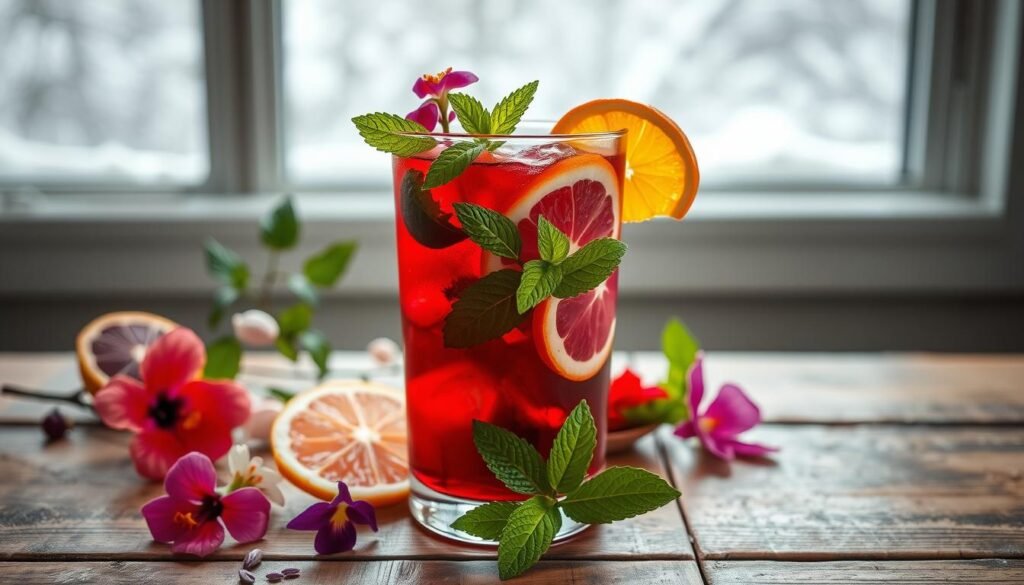
Temperature Recommendations
The ideal serving temperature is key to a great seasonal herbal tea experience. Aim for a warm 140-160°F range. This is hot enough to create steam but cool enough for immediate sipping. For a cozy winter drink, avoid boiling temperatures that might scald the delicate hibiscus flavors.
Glassware Selection
Choose serving vessels that showcase the tea’s stunning ruby-red color:
- Clear glass mugs to highlight the vibrant hue
- Thick ceramic mugs for maximum heat retention
- Tempered glass tumblers for elegant presentation
- Insulated cups for prolonged warmth
Remember, presentation is about creating an experience. Your hibiscus tea isn’t just a drink – it’s a moment of winter comfort waiting to be savored.
Storage Tips and Shelf Life
Keeping spiced hibiscus tea fresh is important. Whether you’ve made a batch or bought dried flowers, the right storage is key. It helps keep the tea’s quality and taste.
For brewed tea, refrigeration is essential. Store it in an airtight glass container for up to 4 days. Glass containers stop flavors from getting in and keep the tea tasting good.
Storage Guidelines for Dried Hibiscus Flowers
- Store in an airtight container
- Keep in a cool, dark place
- Avoid direct sunlight and moisture
- Check color and aroma periodically
Freshness Indicators
| Storage Method | Maximum Freshness Duration | Key Considerations |
|---|---|---|
| Room Temperature | 8-12 hours | Avoid leaving tea out too long |
| Refrigerator | 2-4 days | Use airtight glass containers |
| Freezer | Up to 2 months | Best for cold brew variations |
Look out for signs of spoilage. Unusual color, sour taste, or odd smells mean it’s time to throw it away. Then, make a new batch.
Pro Tips for Tea Preservation
- Use high-quality tea leaves
- Minimize ice addition to prevent flavor dilution
- Consume within recommended timeframes
- Store in clean, sealed containers
Follow these tips to keep your spiced hibiscus tea fresh and tasty every time.
Making Large Batches for Gatherings
Hosting a winter party? Our guide will make you a tea master. Use about ½ cup of dried hibiscus flowers for every 4 cups of water. This ratio gives a rich, vibrant flavor that will wow your guests.
Scaling up hot hibiscus tea is easy. Remember, steeping time is key – aim for 5 minutes for a full flavor. For large volumes, use loose-leaf tea for the best taste, as Bon Appetit experts suggest.
For your hibiscus iced tea, set up a customizable serving station. Offer extra honey, cinnamon sticks, or simple syrup. Since it’s caffeine-free, it’s great for all-day parties. Store leftovers in the fridge for 3 to 5 days.
Whether it’s hot or cold, the secret is in the prep and presentation. Follow these tips to make a drink that warms hearts and delights taste buds at your winter gatherings.
